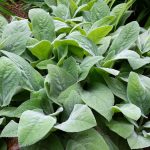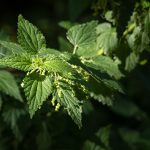Plants have personalities?? Most definitely.
Developing a relationship with a plant is not too dissimilar to developing a relationship with another living being. When we first meet another being we don’t know if we want to be friends with them. Because we don’t know anything about them.
It takes time; and perhaps many meetings and conversations, to get to know someone properly. We don’t pick our friends with someone based on a single feature, such as the colour/texture of their hair.

A very basic illustration is a comparison of Lamb’s-ear and the common Nettle. Lamb’s-ears have wonderfully soft, fuzzy leaves; they have a coating of soft fur-like hairs over the whole of them. Personally I could spend hours sitting and stroking them. I wouldn’t do the same with a nettle. They have very different personalities to each other.
If this is the only thing that people learn about these two plants, they are not going to develop much of a relationship with them. Having been stung by a nettle they may actually spend their whole lives avoiding the plant and never get to know more.

If you are lucky enough to be intuitive you may know from the outset if you would/wouldn’t like to develop a relationship from their vibrations. If you are intuitive you will also pick up vibrations from plants.
Finding a plants Personality
Is a plant soft and fluffy and doesn’t mind being stroked or will sting you? That is just the tip of the iceberg when it comes to learning about it’s personality. How else do we learn about Plants Personalities?
Quite often when I asked Grandma Lukie a question about a plant I would get the reply “why don’t you go and ask it”. She was teaching me how to develop a relationship with the plant for myself. That raises two other questions; ‘How do we develop relationships with plants’? and ‘How do plants communicate with us’? Developing any relationship takes time. It also takes effort.
Botany
If you haven’t been fortunate enough to have been taught about plants organically (on the fly; as you go about normal daily activities), then you are going to have to learn. That is one area where you need to put effort in. You need to learn about how plants grow; their different parts and proceses. And more importantly why a particular plants ‘bits‘ are shaped/coloured/textured etc. the way that they are.
Botany; the properties and life phenomena exhibited by a plant, is an entire field of study devoted to understanding plants personalities. The seeds, the roots, the shoot sytem and the flowers are unique to each plant. The intricacies of each part tell you so much about the plant. How it lives, how it reproduces. What conditions it likes, which other plants it likes or doesn’t like and so much more. It is these intricacies which will help you to identify a plant. Even a brief explanation of botanical science is too complex to present in the space here.
One Plant at a Time
In 2016 it was estimated that there are 390,900 plants known to science. Plants are fundamental to our survival, they provide us with our food, our fuel, our medicines. They even control our climate.
With this many plants it may seem an impossible task to develop the knowledge that allows you to get to know their personalities. The best way to learn is one plant at a time; learn its whole profile. Books are useful but working with the plant itself is essential. Observing the changes that it goes through; during the course of a day or different seasons. Finding out the type of location that a plant choses; the soil type and the relationships that it has with other plants and animal species, how and why it does this.
Plant Language
It is only when you truly know the personality of a plant that you can start to understand it when it talks to you. I have a strong memory of Grandma Lukie talking to a plant in the garden one morning saying, “Ye’r obviously not feeling well, what’s up with ya?”. I immediately wanted to know how she knew that the plant wasn’t feeling well.
She pointed out that it’s flower head should have been starting to point up toward the Sun by that time in the day and it wasn’t, it’s leaves were starting to look limp, they were paler than they should have been and were starting to get a bit of a yellowish tinge to them. Grandma Lukie knew this because she had a good relationship with that plant, knew how it should look and what it’s behavioural patterns were. She told me to go and find another one of those plants and see what the difference was – I did, and it was obvious that the first one was definitely not well. Grandma Lukie decided that as with humans “a good cup of tea” (Comfrey) would make it feel better. ‘How & Why Comfrey Tea works‘ is a future article, with a recipe that doesn’t smell like something rotting.
This is how plants talk to us and it is only if we have developed a relationship and know their personality that we can ‘hear‘ what they are saying.
Two Plants Personalities, where we started
What do features that we mentioned of the two plants that we started with tell us about them?
- Lamb’s-ear (Stachys byzantina) – the soft fuzzy hairs that cover lamb’s-ear are known as trichomes, they protect the plant from excess transpiration (water movement from the soil to the atmosphere via plants), high temperature, radiation, ultraviolet (UV) light, and herbivore attack. This will tell us that the plant is native to places that are hot, dry and very sunny. As a result it will resist drought but go rotten in wet humid conditions. (In this case it is native to the Middle East).
- Stinging Nettle (Urtica dioica) – the stinging nettles needle-like hairs are hollow and loaded with toxic histamine, serotonin and formic acid which is an adaptation to provide protection from predators. This tells us that the plant doesn’t need the same level of protection from heat and Sun and is more likely to be native to where we find it growing; as a result it will have more of a propensity to become a nuisance (a weed). In fact it grows primarly in temperate biomes and is native from Europe to Siberia.
The absolute, most reliable resource for checking plant profiles is Kew Gardens ‘Plants of the World Online‘.
